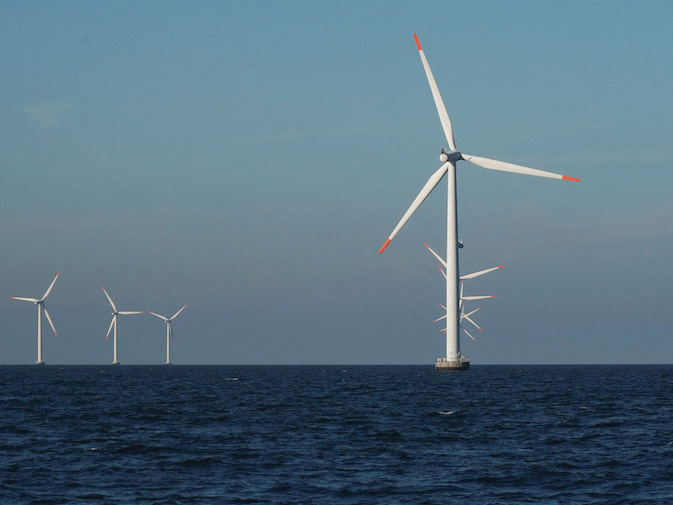Ajot: Are Trump’s cutbacks in renewables undermining the AI race with China?
China’s race to surpass the United States in AI is partly supported by “the country’s abundant green energy resources (which) may also enable it to achieve comparable computing power with less efficient home-grown chips,” according to a reporter from the Hong Kong-based and Alibaba Group-owned South China Morning Post.
As President Trump leads the charge in cutting back renewable energy investments, including cancelling offshore wind farm contracts, he may, unintentionally, be undermining US AI leadership and helping China catch up.The reason begins with the fact that China has set a new benchmark in its transition to renewable energy, with wind and solar power sources generating 26% of the nation’s electricity in April 2025. The acceleration of solar capacity installations has been a key driver behind this growth. In 2024, China’s new solar capacity exceeded the combined total of the rest of the world, with an increase from 103GW in 2022 to 333GW in 2024, according to Power Technology.
In contrast, renewable energy provided about 9% of total US energy consumption in 2023, according to the US Department of Energy.
At the same time, household electricity bills have increased by 10% since Trump re-entered the White House, a new report has found, with its authors highlighting the impact of the president’s support of data centers and AI, as well as cuts to clean energy projects, as part of the cause, according to a report by Energy Innovation.
A 2025 International Energy Agency (IEA) report, Energy and AI, states, “The United States accounted for the largest share of global data centre electricity consumption in 2024 (45%), followed by China (25%) and Europe (15%). Globally, data centre electricity consumption has grown by around 12% per year since 2017… Data centre electricity consumption is set to more than double to around 945 TWh [Terawatt-hour] by 2030. This is slightly more than Japan’s total electricity consumption today. AI is the most important driver of this growth, alongside growing demand for other digital services. The United States accounts for by far the largest share of this projected increase, followed by China. In the United States, data centres account for nearly half of electricity demand growth between now and 2030.”
As a result, the report says, a diverse range of sources will be needed to meet the AI demand: “Renewables and natural gas take the lead in meeting data centre electricity demand, but a range of sources are poised to contribute. Half of the global growth in data centre demand is met by renewables, supported by storage and the broader electricity grid. Renewables generation is projected to grow by over 450 TWh to meet data centre demand to 2035, building on short lead times, economic competitiveness, and the procurement strategies of tech companies.”
The Energy Equation
Without the US growth in renewables, the superior technology of Nvidia H-20 semiconductors that support the US AI developers might be offset by China’s investments in wind and solar energy, which provide additional power generation to offset the differential in Chinese computing power.
This development is happening as the Trump administration is cutting back on renewables, and so is unintentionally undermining US AI leadership. The impact is seen in energy losses incurred by cutting back on new power generation that was about to be deployed by proposed wind farms off the Atlantic and Pacific coasts of the US.
In an August 7th webinar, South China Morning Post Technology Editor Zhou Xin, Senior Correspondent William Zheng, and tech reporters Ben Jiang and Danielle Popov addressed questions about China’s open-source marketing strategy and its potential impact on the global AI landscape.
SCMP Senior Correspondent William Zheng noted: “Because I think one of the less talked about aspects is that China has lots of green energy. So, it can stack up more chips to perform the same (as the Nvidia) H20 because of all the solar, all the windmills, and all these green initiatives that have been put in to give Chinese companies a whole good dose of green energies. I think those are very cheap and pretty good. So, China can afford to do that. If the next morning, President Donald Trump decided that ‘I’m going to stop the (Nvidia) H20 export to China,’ then China will have no choice but to switch back to Chinese hardware, Chinese software, and everything. Then it will speed up the whole process of adoption.”
This process of switching to Chinese semiconductors may have begun. Chinese authorities summoned domestic companies, including internet firms Tencent and ByteDance, to discuss their H20 chip purchases, “expressing concerns over information risks.” The result is that on August 21st, Nvidia reportedly suspended sales of H20 chips to China, according to Reuters. At the same time, China is supporting an open-source strategy to challenge and surpass the US, emphasizing market share over short-term profitability, the SCMP panelists said.
SCMP Technology Reporter Danielle Popov explained what the implications for China might be moving forward, “Chinese AIs are open source, which means they’re customizable, implementable, and usable. That’s the difference between them and the US closed-source models. As such, Chinese models like DeepSeek actively outperform Meta and OpenAI. They’re also free to download and free to utilize. Like we’ve mentioned, US closed source models have a $200 monthly subscription fee. You don’t have that with Chinese models as well as their lower costs to actually develop.”
China’s Digital Population
As SCMP’s Tech Reporter Danielle Popov pointed out, “I think we forget that China has one of the largest digital populations in the world, and as such, it has a very rich internal stream of data that it can collect from e-commerce, urban management, social media, and finance. And this database is used as a very robust training foundation for these models.
China also uses AI as a strategic (tool) for economic and social development, not just a market-driven technology, which is how the US sees it. China also has plans to implement it in everyday infrastructure, and as you can see with the new generation AI plan, China is projected to become a worldwide AI leader by 2030.
Its strong technological and governance backing also leads it to expand globally. And again, these open-source language models are free to implement, adjust, and edit. So, they’re very desirable for emerging economies as they’re cost-efficient (compared) to their Western counterparts.”
Related Posts




